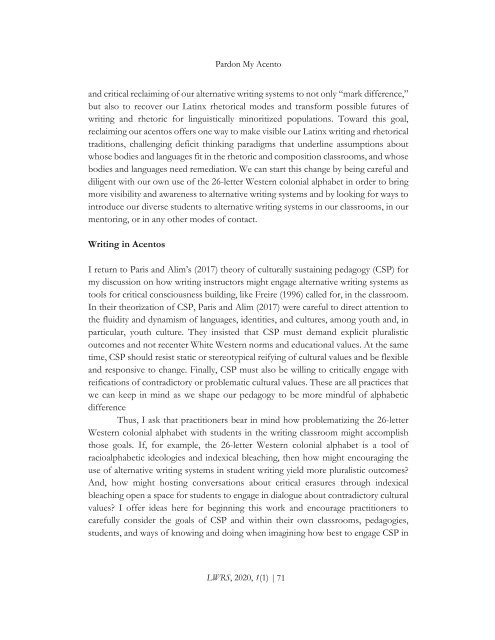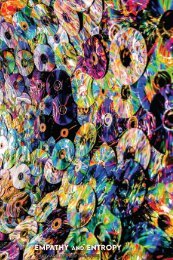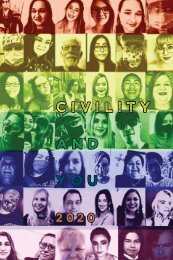LWRS June 2020 Volume 1, Issue 1
Inaugural Issue co-edited by Yndalecio Isaac Hinojosa and Isabel Baca
Inaugural Issue co-edited by Yndalecio Isaac Hinojosa and Isabel Baca
Create successful ePaper yourself
Turn your PDF publications into a flip-book with our unique Google optimized e-Paper software.
Pardon My Acento<br />
and critical reclaiming of our alternative writing systems to not only “mark difference,”<br />
but also to recover our Latinx rhetorical modes and transform possible futures of<br />
writing and rhetoric for linguistically minoritized populations. Toward this goal,<br />
reclaiming our acentos offers one way to make visible our Latinx writing and rhetorical<br />
traditions, challenging deficit thinking paradigms that underline assumptions about<br />
whose bodies and languages fit in the rhetoric and composition classrooms, and whose<br />
bodies and languages need remediation. We can start this change by being careful and<br />
diligent with our own use of the 26-letter Western colonial alphabet in order to bring<br />
more visibility and awareness to alternative writing systems and by looking for ways to<br />
introduce our diverse students to alternative writing systems in our classrooms, in our<br />
mentoring, or in any other modes of contact.<br />
Writing in Acentos<br />
I return to Paris and Alim’s (2017) theory of culturally sustaining pedagogy (CSP) for<br />
my discussion on how writing instructors might engage alternative writing systems as<br />
tools for critical consciousness building, like Freire (1996) called for, in the classroom.<br />
In their theorization of CSP, Paris and Alim (2017) were careful to direct attention to<br />
the fluidity and dynamism of languages, identities, and cultures, among youth and, in<br />
particular, youth culture. They insisted that CSP must demand explicit pluralistic<br />
outcomes and not recenter White Western norms and educational values. At the same<br />
time, CSP should resist static or stereotypical reifying of cultural values and be flexible<br />
and responsive to change. Finally, CSP must also be willing to critically engage with<br />
reifications of contradictory or problematic cultural values. These are all practices that<br />
we can keep in mind as we shape our pedagogy to be more mindful of alphabetic<br />
difference<br />
Thus, I ask that practitioners bear in mind how problematizing the 26-letter<br />
Western colonial alphabet with students in the writing classroom might accomplish<br />
those goals. If, for example, the 26-letter Western colonial alphabet is a tool of<br />
racioalphabetic ideologies and indexical bleaching, then how might encouraging the<br />
use of alternative writing systems in student writing yield more pluralistic outcomes?<br />
And, how might hosting conversations about critical erasures through indexical<br />
bleaching open a space for students to engage in dialogue about contradictory cultural<br />
values? I offer ideas here for beginning this work and encourage practitioners to<br />
carefully consider the goals of CSP and within their own classrooms, pedagogies,<br />
students, and ways of knowing and doing when imagining how best to engage CSP in<br />
<strong>LWRS</strong>, <strong>2020</strong>, 1(1) | 71





